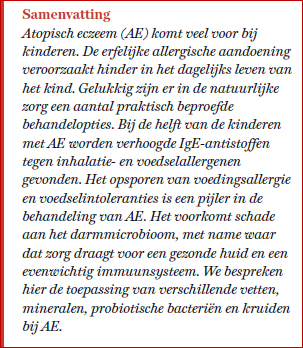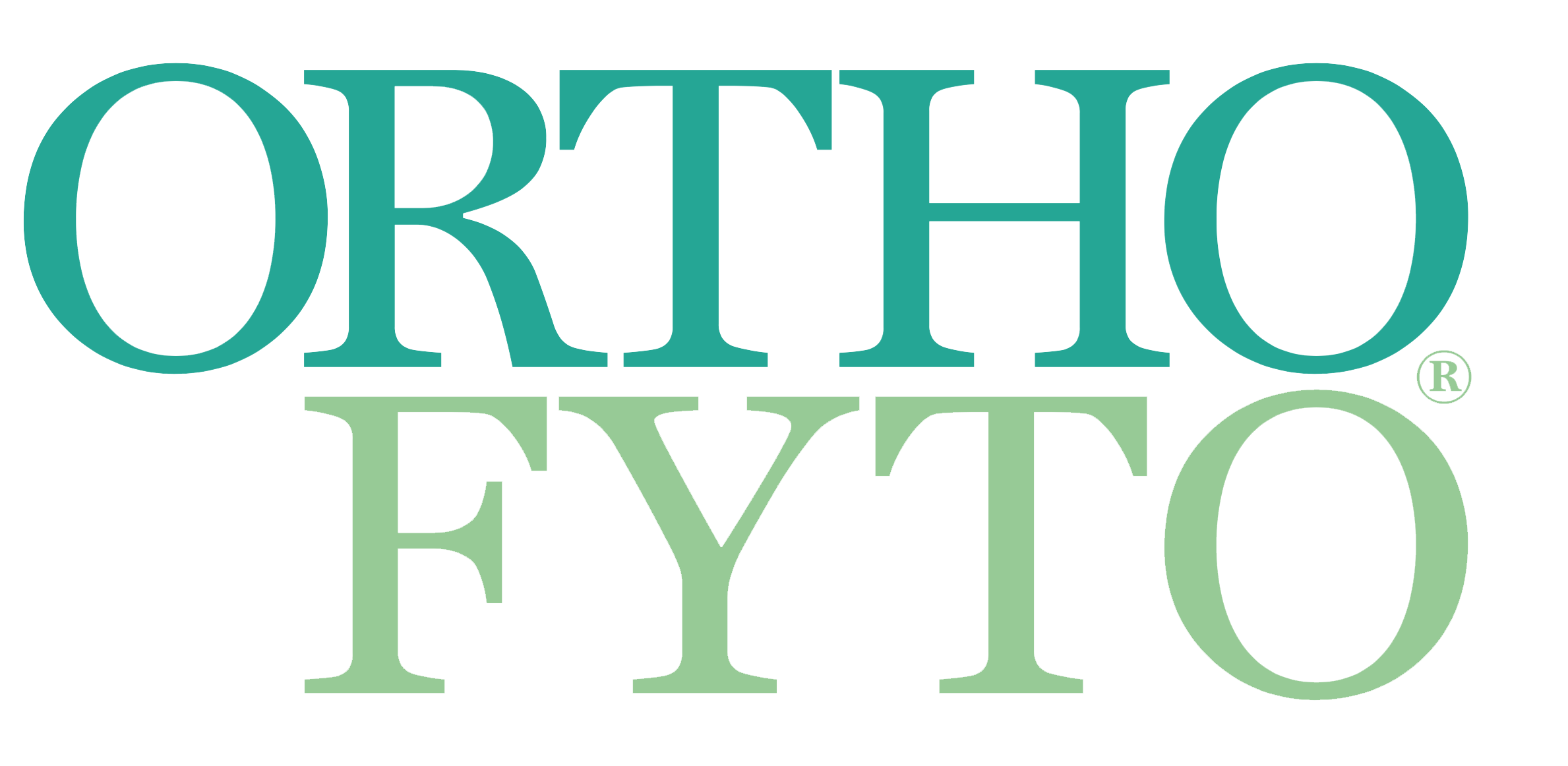Atopisch eczeem bij kinderen
12 Aug, 2020
Door: Marilène Dols
 Sinds decennia stijgt het aantal allergische aandoeningen zoals atopisch eczeem, astma, hooikoorts en voedselallergie. Kinderen worden het meest getroffen door AE, ook constitutioneel eczeem of atopische dermatitis genoemd: 5-15% tegen 1-3% van de volwassenen. Hoe jonger het kind, des te meer klachten. Gemiddeld krijgt 14% van de baby’s jonger dan één jaar AE, maar als beide ouders, óf moeder en een ouder kind, een allergische aandoening hebben, stijgt die kans met 50-80%. De meeste kinderen groeien over AE heen; 80% heeft met 15 jaar geen klachten meer.1
Sinds decennia stijgt het aantal allergische aandoeningen zoals atopisch eczeem, astma, hooikoorts en voedselallergie. Kinderen worden het meest getroffen door AE, ook constitutioneel eczeem of atopische dermatitis genoemd: 5-15% tegen 1-3% van de volwassenen. Hoe jonger het kind, des te meer klachten. Gemiddeld krijgt 14% van de baby’s jonger dan één jaar AE, maar als beide ouders, óf moeder en een ouder kind, een allergische aandoening hebben, stijgt die kans met 50-80%. De meeste kinderen groeien over AE heen; 80% heeft met 15 jaar geen klachten meer.1
AE bij jonge kinderen kan onderscheiden worden van ‘berg’, een onschuldige vorm van seborroïsch eczeem van de hoofdhuid, en luiereczeem, een vorm van irritatief contacteczeem. Bij de helft van de kinderen met AE worden verhoogde IgE-antistoffen tegen inhalatie-en voedselallergenen gevonden. Ze zijn terug te voeren op een disbalans tussen Th1- en Th2-lymfocyten waarbij Th2 is verhoogd. Th1 en ook Treg, die evenwicht brengt tussen Th1 en Th2, zijn verlaagd. Bij een inhalatieallergie triggeren allergenen zoals huisstofmijt, honden- of kattenhuidschilfers en schimmels het immuunsysteem met aanwakkering van de huidontsteking. Gaat inhalatieallergie een grotere rol spelen naarmate het kind ouder wordt, bij jonge kinderen staat voedselallergie op de voorgrond.
Koemelkallergie is de meest voorkomende allergie bij jonge kinderen en wordt bij 1-3% van de zuigelingen geconstateerd, maar bij AE-kinderen is die kans tweemaal zo hoog vanwege hun atopische aanleg. Een aanwijzing voor koemelkallergie is het ontstaan van (allergische) klachten bij de overgang van borstvoeding naar kunstvoeding.2
Een aantal ouders met familiaire atopie-aanleg mijdt zekerheidshalve koemelkproducten en gebruikt geitenmelkproducten voor hun kind. Daar is iets voor te zeggen. Niet alleen is geitenmelk lichter verteerbaar, in vergelijking met koemelkflesvoeding vertoont het darmmicrobioom van twee maanden oude baby’s die gevoed worden met geitenmelkflesvoeding, de meeste overeenkomst met borstvoedingsbaby’s.3
Koemelkallergie is tijdelijk; met drie jaar is 90% van de kinderen klachtenvrij. Van hen ontwikkelt echter 25-50% andere voedselallergieën, bijvoorbeeld voor kippenei, pinda, noten, appel, soja, sesamzaad, vis of schaal-en schelpdieren. Recent onderzoek wijst echter uit dat één keer per week vis eten in het eerste levensjaar, en niet pas vanaf twee jaar, de kans op AE maar ook op astma en benauwdheid vermindert in het zesde levensjaar.4 Van de bijvoeding die de baby in de eerste maanden krijgt, blijkt vooral kiwi sterk allergeen; die laat men beter achterwege.2
www.marilenedols.nl Lees het gehele artikel vanaf pagina 12 in OrthoFyto 4/20. Wilt u het gehele artikel als PDF bestand ontvangen? Bestel het dan hier voor € 3,50 Bronvermelding:- Niers, L. (2009) The Effects of Selected Probiotic Strains on the Development of Eczema (The PandA Study). Allergy Sep;64(9):1349-58.
- Kist-van Holthe, J.E et al. (2013) JGZ-richtlijn Voedselovergevoeligheid.
- Tannock GW et al. (2013) Comparison of the compositions of the stool microbiotas of infants fed goat milk formula, cow milk-based formula, or breast milk. Appl Environ Microbiol. May;79(9):3040-8.
- Øien T et al. (2019) Fish Consumption at One Year of Age Reduces the Risk of Eczema, Asthma and Wheeze at Six Years of Age. Nutrients. Aug 21;11(9).
- Abrahamsson TR et al. (2012) Low diversity of the gut microbiota in infants with atopic eczema. J Allergy Clin Immunol. Feb;129(2):434-40, 440.e1-2.
- Lin RJ et al. (2015) Protective effect of probiotics in the treatment of infantile eczema. Exp Ther Med. May;9(5):1593-1596.
- Thijs C et al. (2011) Fatty acids in breast milk and development of atopic eczema and allergic sensitisation in infancy. Allergy.Jan;66(1):58-67.
- van Gool C et al. (2003) Gamma-linolenic acid supplementation for prophylaxis of atopic dermatitis--a randomized controlled trial in infants at high familial risk. Clin Nutr.Apr;77(4):943-51.
- Huurre A et al. (2008) Impact of maternal atopy and probiotic supplementation during pregnancy on infant sensitization: a double-blind placebo-controlled study. Clin Exp Allergy Aug; 38(8):1342-8.
- Böttcher MF et al. (2008) Low breast milk TGF-beta2 is induced by Lactobacillus reuteri supplementation and associates with reduced risk of sensitization during infancy. Pediatr Allergy Immunol. Sep;19(6):497-504.
- Youngshin Han et al. (2012) Randomized Trial of Lactobacillus Plantarum CJLP133 for the Treatment of Atopic Dermatitis. Pediatr Allergy Immunol, 2012 Nov;23(7):667-73.
- I-J Wang et al. (2015) Children With Atopic Dermatitis Show Clinical Improvement After Lactobacillus Exposure. Clin Exp Allergy, Apr;45(4):779-87.
- Wickens et al. (2012) A Protective Effect of Lactobacillus Rhamnosus HN001 against Eczema in the First 2 Years of Life Persists to Age 4 Years. Clin Exp AllergyJul;42(7):1071-9.
- Wang X et al. Zinc supplementation modifies tight junctions and alters barrier function of CACO-2 human intestinal epithelial layers. Dig Dis Sci. 2013 Jan;58(1):77-87.
- Hattangdi-Haridas SR et al. Vitamin D Deficiency and Effects of Vitamin D Supplementation on Disease Severity in Patients with Atopic Dermatitis: A Systematic Review and Meta-Analysis in Adults and Children. Nutrients. 2019 Aug 9;11(8).
- Siegfired Bäumler (2013) Heilpflanzen Praxis Heute Band 2 Rezepturen und Anwendung. Elsevier Urabd & Fischer 2013. ISBN 978-3437572739
- Evangelista MT et al. (2014) The effect of topical virgin coconut oil on SCORAD index, transepidermal water loss, and skin capacitance in mild to moderate pediatric atopic dermatitis: a randomized, double-blind, clinical trial. Int J Dermatol. Jan;53(1):100-8.
- Fowler JF et al. (2012) Colloidal Oatmeal Formulations as Adjunct Treatments in Atopic Dermatitis. J Drugs Dermatol, Jul;11(7):804-7.
- Saeedi M. et al. (2003) The Treatment of Atopic Dermatitis With Licorice Gel. J Dermatolog Treat Sep;14(3):153-7.
- Patzelt-Wenczler R et al. (2000) Proof of efficacy of Kamillosan(R) cream in atopic eczema. Eur J Med Res.Apr 19;5(4):171-5.
- Eschborn C M Schempp et al. (2000) Topical Application of St John's Wort (Hypericum Perforatum L.) and of Its Metabolite Hyperforin Inhibits the Allostimulatory Capacity of Epidermal Cells, Br J Dermatol, May;142(5):979-984.
- Wölfle U. et al. (2018) Bitterstoffe – von der traditionellen Verwendung bis zum Einsatz an der Haut. Zeitschrift für Phytotherapie 39(5):210-215.
- Seiwerth, J. (2019) Anti-Inflammatory Effect of a Novel Topical Herbal Composition (VEL-091604) Consisting of Gentian Root, Licorice Root and Willow Bark Extract. Planta Med May;85(7):608-614.
